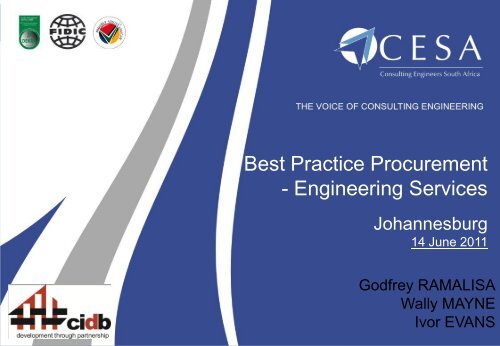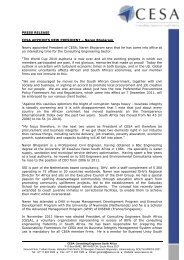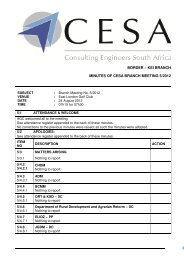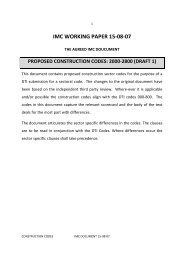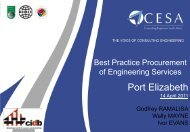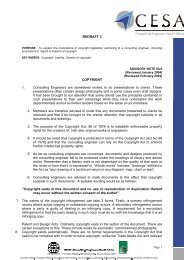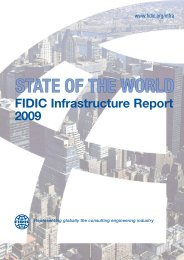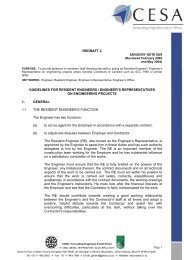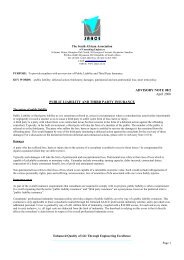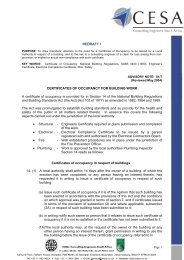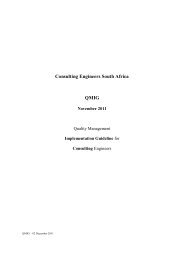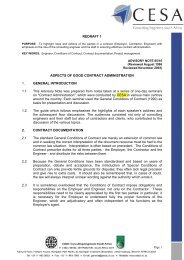Best Practice Procurement - Engineering Services - Cesa
Best Practice Procurement - Engineering Services - Cesa
Best Practice Procurement - Engineering Services - Cesa
- No tags were found...
Create successful ePaper yourself
Turn your PDF publications into a flip-book with our unique Google optimized e-Paper software.
<strong>Best</strong> <strong>Practice</strong> <strong>Procurement</strong>- <strong>Engineering</strong> <strong>Services</strong>Johannesburg14 June 2011Godfrey RAMALISAWally MAYNEIvor EVANS
IntroductionIdentifying the challenges – by CESAIndustry and Society under distressThe lack of technical managementcapacityDelayed paymentFew work opportunitiesLower marginsLack of infrastructure maintenanceBribery and corruption(un-reasonable bribe)Inexperienced officials andconsultantsPoorly defined scope of works andservicesPoor procurement practices(deviations)Inappropriate constructionprocurement models
Introduction (cont‟d)Barriers to Construction Quality - cidbDesign<strong>Procurement</strong>ConstructionCorruption• Inadequatedetails andspecification• Poor designcoordination• Emphasis ontime andbudget• Shortenedproject periods• Lack ofprequalification• Competitivetendering• Awards ofcontractsprimarily onprice• Skills shortage• Insufficientworkforcetraining• Lack ofmanagementcommitment• Lack of strictquality control• Corruption• Corruption• Corruption• Corruption• (bribery,extortion andfraud)cidb discussion document : Construction Quality in South Africa; A client perspective
Introduction (cont‟d)Barriers to Construction Quality - cidbSurvey:Barriers to Construction QualityParticipants:1. Public clients2. Designers3. Project managers4. ContractorsPoor site managementLack of contractor quality expertiseCorruptionInadequate resourcing by contractorsLack of understanding of qualityLevel of subcontractingInadequate informationDetailFocus on cost by contractorsPoor constructability
Introduction (cont‟d)Causes of the challenges - Deterioration in Quality1. <strong>Procurement</strong> of CE services based on PRICE- A major cause is the diminished quality of design- Lower quality design results when engineeringservices are procured as a commodity- The procurement of engineering services in which costis a factor (QCBS) promotes engineering services ascommodity servicesOther factors contribute as well, including:2. Corruption3. Incompetent contractors4. Poor project management5. Lack of resources to manage contractors
Introduction (cont‟d)Identifying the challenges– <strong>Procurement</strong> Indaba 2008 –« Working smarter to address Supply Side Challanges and EliminateBottlenecks in the Construction Economy »‣ Similar concern where identifiedOutcomes• Write simplified step-by-step <strong>Best</strong> <strong>Practice</strong> <strong>Procurement</strong>Guideline Manual, drawn in collaboration with the cidb• National roll-out• and revised with inputs from 2010 Roadshow
Introduction (cont‟d)Seminar - Objectives1. To inform and capacitate clients and consulting engineerson procurement best practice2. Instigate delivery of consulting engineering services in truevalue–added context3. Instigate compliance to the requirements of procurementcontracts ito CIDB & Treasury legislation4. To provide CE‟s and clients a platform to makesuggestions to the best practice procurement guidelinemanual.
Introduction (cont‟d)Our MissionCreate a conducive sustainable procurement environment to enhancedinfrastructure delivery, in terms of speed, time and cost (quality outcome).Ensure that the right firm(s) are appointed for the right jobAppointment at a reasonable level of compensationEnsure continued existence and development of firm(s) and industryServe the best interests of public
Introduction (cont‟d)<strong>Best</strong> Interest of the PublicCost effective, Reasonable priced / feeMoney spent on projects once,no rebuildingSafe, User friendly and ReliableInfrastructureAppropriate Infrastructure
Introduction (cont‟d)Outline - CESA Guideline Manual/BriefingChapter 1.Chapter 2.Chapter 3.Chapter 4.Chapter 5.Chapter 6.Chapter 7.Chapter 8.Project Life-cycleConsulting <strong>Engineering</strong> <strong>Services</strong><strong>Procurement</strong> of Consulting <strong>Services</strong>Scope - expanded description of elements of scopeTender Documentation for CESValue – Added <strong>Services</strong> – value of additional CESEvaluation of tendersPerformance monitoring – Suggested framework for CPE.
Dire Consequences:„Appointingthe wrong firmforthe right job‟
Example:„House & Bridge‟ Consulting EngineersSpecialist in portable house and bridgesDesign & ConstructionAssignment:Three relatively easy questions.Question # 1:How much does a house weigh?Question # 2:How much weight can a rural two-lane bridgeHold???
Unskilled firm for the right job“… a house becomes a bridge”
Under-qualified firm for the right jobQuestion # 3Would this be covered byPI,Home insurance,car insurance,or,Does it come under the roadside accident fund ???---------------------------------------------------------------------------------------------------------------We can all relate to this, e.g.Nov09: “40 000 defective RDP houses to beflattened and rebuilt at a cost > R1-billion”.Feb2011: rebuild about 50000 low-costhouses - thousands more than expected.“… delivers questions rather than intended product”
Under-resourced firm is a …We can relate to this: R4 million bridge swallows a taxi!“… waste of Tax Payers Money” and indeed COUNTER REVOLUTIONAY !!!
“I told you to use Quality Principles to build this Bridge / House”9DisposalRenewal1Identification2Definition8Operations7ConstructSolution:Using Qualityprinciplesthroughout projectlife-cycle3Feasibility4ConceptQualityStakeholders:1. Public clients2. Designers3. Projectmanagers4. Contractors6Procure5Design
- Solution –Use of Quality principlesSession 1
SESSION 11.1 Consulting Engineers South Africa1.2 Consulting <strong>Engineering</strong> Industry1.3 The Project Life-Cycle1.4 Overview of Consulting <strong>Services</strong>
1.1Consulting Engineers South Africa (CESA)
Consulting Engineers South AfricaHistory (see page 1)• South African Association of ConsultingEngineers (SAACE) founded in 1952• Original membership 30 individuals• August 2008 - SAACE transformed toConsulting Engineers South Africa (CESA)• Consists of 480 private CE firms – stillgrowing• Employing more than 22 000 people
Consulting Engineers South AfricaRole of CESAPromote interests of Members and Clients by:• Regular liaison meetings• <strong>Engineering</strong> comment on legislation etc• Advisory Notes for Members and Clients• New/revised contracts/forms of agreement• Guidelines on professional practice matters• A peer review and quality management programme• Seminars, workshops and conferences• FIDIC (International Federation of CE Associations)
Consulting Engineers South Africa - contdProfessionalism and Integrity of Members:1. In general:• ECSA registers professional individual engineers,technologists etc• CESA „registers‟professional Consulting Engr Firms2. Credibility of applicants• In business > 12 months• Nominated & Seconded by CESA member firms3. Ongoing requirements• Subject to CESA Code of Conduct (includes BIMS)• Ownership/principals > 50% Pr Engrs/Techno‟s• Primary work (Consulting <strong>Engineering</strong>)• QMS in place Developing Integrity Pact (see Appendix A)
1.2Consulting <strong>Engineering</strong> Industry• Consulting <strong>Engineering</strong> Industry Overview• Construction Industry – Enabler & Regulator
Consulting <strong>Engineering</strong> Industry OverviewThe birth (see page 5)• ‟Engineer‟ first appeared in 15 th Century - in the military• „Non-military engineers‟ in civilian capacity– hence „civil engineers‟• Associations formed to exchange experiences – improve status• <strong>Engineering</strong> formalised as profession‣ safeguard health & welfare of public‣ prevent unqualified people from selling engineering services• Associations formed to promote learning and the profession• Sanitation voted greatest medical advance since 1840 – BMJ
Consulting <strong>Engineering</strong> Industry OverviewThe order today• Non-reservation of engineering work – tenderpreneurs• Tendering process – Price >>> Quality, engineering as commodity• Ignorance – competence/value of CEs unrecognised• Contractors & CEs - world class – Soccer World Cup infrastructure• CEs Environment‣ corruption‣ non-technical managers – 5 year contracts – deployment‣ poor schooling – maths/ science‣ silo effect, non – integration• <strong>Engineering</strong> need recognised by President eg „30 000 engineers by 2014‟
Consulting <strong>Engineering</strong> Industry OverviewThe future• Competitive tendering here to stay – not to drive professional fees down• Struggle continues‣ professionalism – modern, faster ECSA registration,‣ reservation of engineering work – CBE - approve ECSA IDoEW‣ service delivery - use of appropriate procurement methods‣ Register of Professional Service Providers• Up there with other professionals (doctors, lawyer, CA, etc)“Change is upon us; there is no future in the status quo; industrymust adapt. --- Firms must grow in capability and scope ofservices to meet the client demands. We must move „up thefood chain‟ to a new set of value-added services for our clients.”FIDIC Report <strong>Engineering</strong> Our Future
The World Without Engineers
The World Without Engineers
Construction Industry Enabler and RegulatorThe Construction Industry Development Board (see page 3)Established by and gets its mandate from the CIDB Act (38 of 2000)Aims:• Promote sustainable growth - construction industry - sustainableparticipation of emerging sector• Promote improved performance & best practice - public andprivate sector clients, contractors and other participants• Promote - procurement & delivery management - uniformapplication of policy - all spheres of government - uniform andethical standards - guided by a Code of Conduct• Establish registers - tool - systematically regulate & monitor theperformance of industry and stakeholders‣ Register of Contractors(RoC)‣ Register of Projects (RoP)‣ Register of Prof Service Providers (RoPSP)
Construction Industry Enabler and RegulatorRegister of Prof Service Providers (RoPSP)Size of firm&No. of registered personsSize / Value of completed projects&Financial RecordsDatabaseEmpowermentExperienceThe Pilot Scheme – Performance Based Register1. Review qualification and client references2. Performance assessments and reflection of scores
Construction Industry Enabler and RegulatorCode of Conduct establishes certain standards ofbehaviour…• Behave equitably, honestly and transparently.• Discharge duties and obligations timeously and with integrity.• Comply with all applicable legislation and associated regulations• Satisfy all requirements established in procurement documents• Avoid conflict of interest• Not maliciously injure/ attempt to injure the reputation of 3 rdparty
Construction Industry Enabler and RegulatorMonitoring role - CIDB can:• Conduct investigations• Sanction offenders• Suspend offenders from the CIDB RoC• Issue fines to Employers up to R100 000• Intergovernmental Relations Framework Act – liaises with:‣ Treasury‣ Public Protector‣ Auditor GeneralCIDB documentation/prescripts• Standard of Uniformity (SFU)• Code of Conduct• <strong>Practice</strong> notes/ Legislation(see Appendix I – useful websites)
Construction Industry Enabler and RegulatorMOMERANDUM OF UNDERSTANDINGfor monitoring of compliance in public sectorprocurement:Entered into between :Construction Industry Development Board(“CIDB”)andConsulting Engineers South Africa(“CESA”)
1.3The Project Life Cycle (see page 11)
The Project Life Cycle9Disposal /Renewal1Identification2Definition8Operations &Maintenance3Feasibility7Construct4Concept &Viability6Procure5Design
The Project Life CycleThe Project Life Cycle (cont‟d)Steps 1 to 3 : Identification, Definition, Feasibility• Identifying the potential project – often by Owner, Specialist assistance• And defining the best project to meet the need• Reject unsuitable solutions, shortlist suitable alternatives• Select the best project, based on technical and financial feasibility• Asset management planningSteps 4, 5, 6 : Concept & Viability, Design, Procure• Developing the project through all concept and viability stages, confirmviability• Detail design of the project to procure construction• Design can be a maintenance/operation assignment• Procuring a contractor to construct – proper tender/contractdocuments, proper evaluation of tenders
The Project Life CycleThe Project Life Cycle (cont‟d)Steps 7, 8, 9: Construct, Operate and Maintain, Disposal/ Renew• Construction:‣From site handover to when Owner takes possession of theconstructed project‣Final handover after Defects Liability Period expired and defectsrectified• Operation and Maintenance:‣Usually by Owner - According to manuals and own procedures‣O & M - May be contracted out• Disposal/Renewal:‣Actions at end of Operations & Maintenance period‣Close down or renew facility etc for another periodNote: CE may be appointed for any one, or all, of the steps 1 to 9
1.4 Overview of Consulting <strong>Engineering</strong><strong>Services</strong> (see page 13)
Fee income earned by Sub-disciplines:% Share - December 2010Tow n planningStructuralQuantity SurveyingProject ManagementMiningMechanicalMarineInformation Systems / TechnologyHydraulicsGISIndustrial Process / ChemicalGeotechnicalFacilitiesEnvironmentalElectrical / ElectronicCivilMechanical building <strong>Services</strong>ArchitectureAgricultural0% 5% 10% 15% 20% 25% 30% 35% 40% 45%Source: CESA BECS
Fee earnings by sector: Market ShareOtherAgriculture / Forestry / FishingCommercialHousingTourism/LeisureHealthEducationMining / QuarryingDEC10JUN10DEC09DEC08DEC07EnergyTransportationWater0.0% 5.0% 10.0% 15.0% 20.0% 25.0% 30.0% 35.0% 40.0%Source: CESA BECS
Overview of Consulting <strong>Engineering</strong> <strong>Services</strong>Value of <strong>Services</strong> – by project stages1. Early project stages:• <strong>Engineering</strong> <strong>Services</strong> deliver most value• Functionality & quality of the proposed service more important thanCost (Steps 1 to 3)2. After project is well defined:• <strong>Services</strong> are easier to determine• Role of high level expertise reduces as project develops• Efficient more routine tasks more important• Correct/comprehensive contract documentation is vital
Required Expertise and Value over Project Life CycleStep in Project Life CycleIdentificationDefinitionFeasibilityConcept and ViabilityDesign<strong>Procurement</strong>ConstructionOperations and MaintenanceDisposal or RenewalRequired expertise and potential for valueStrategic concepts and lateral thinking to identify appropriate optionsincluding asset management planningOperational and value options to define projects that are likely to befeasible and cost-effective.Identification and elaboration of possible alternatives and costeffectiveness.Project optimisation subject to budget and environmental constraints.Quick and effective design detailing and incorporation of latestappropriate technological developments.Good contract documentation, accurate schedule of quantities andappropriate procurement optionsConscientious construction administration and monitoring and effectivehandling of contractual issuesAsset management and preventative maintenanceEnvironmentally complaint, dismantling/ demolition or rehabilitation orreconstructing for further use
How to Procure <strong>Engineering</strong><strong>Services</strong>Session 2
SESSION 22.1 How to Procure <strong>Engineering</strong> <strong>Services</strong>
<strong>Procurement</strong> of Consulting <strong>Engineering</strong> <strong>Services</strong><strong>Procurement</strong> ≈ TenderingTo Note:Tendering of professionalengineering services isunique<strong>Services</strong> cannot beawarded based onprice/lowest price onlyLowDevelopmentLowerExpertiseLowestPriceLessOptimizationSuperior qualificationsand experience forms theparamount basis forselecting CEPoor Quality /OutcomePoorPerformance
<strong>Procurement</strong> of Consulting <strong>Engineering</strong> <strong>Services</strong>Important that Government recognises:• CE‟s are an important pool of expertise & skilled resources• High standard of engineering & Infrastructure dev vital for growth• National Treasury policy statement:“It is necessary that certain minimum standards of quality andefficiency be achieved when appointing consultants”• Need to maintain a basic policy of competitive selectionLegal Environment for consulting engineering services:• Constitution of South Africa• System is to be Fair, Equitable, Transparent, Competitive, Costeffective• Adopted by ISO in ISO 10845 series for construction procurement
TABLE : PILLARS OF PROCUREMENTSystemrequirementFairEquitableTransparentCompetitiveCost- effectivePromotion ofotherobjectivesQualitative description of requirementThe process of offer and acceptance is conducted impartially without bias, and providesparticipating parties simultaneous and timely access to the same information.Terms and conditions for performing the work do not unfairly prejudice the interests of theparties.The only grounds for not awarding a contract to a tenderer who complies with allrequirements are restrictions from doing business with the organization, lack of capability orcapacity, legal impediments and conflicts of interest.The procurement process and criteria upon which decisions are to be made shall bepublicized. Decisions (award and intermediate) are made publicly available together withreasons for those decisions. It is possible to verify that criteria were applied.The requirements of procurement documents are presented in a clear, unambiguous,comprehensive and understandable manner.The system provides for appropriate levels of competition to ensure cost-effective and bestvalue outcomes.The processes, procedures and methods are standardized with sufficient flexibility to attainbest value outcomes in respect of quality, timing and price, and the least resources toeffectively manage and control procurement processes.The system may incorporate measures to promote objectives associated with a secondaryprocurement policy subject to qualified tenderers not being excluded and deliverables orpreferencing criteria being measurable, quantifiable and monitored for compliance.
<strong>Procurement</strong> of Consulting <strong>Engineering</strong> <strong>Services</strong><strong>Procurement</strong> - Need to maintain a reasonable Balance betweenCompetition & CompensationCompetitionCompensation- Hong Kong strive for minimum competition -
<strong>Procurement</strong> of Consulting <strong>Engineering</strong> <strong>Services</strong>Primary Legislation Regulating <strong>Procurement</strong> - Refer to Table 3.2, page 11Constitution of the Republic of South Africa (Act No. 108 of 1996) - Section217 states that government procurement systems must be Fair, Equitable,Transparent, Competitive and Cost EffectiveFair, Transparent, Competitive, Cost EffectiveEquitablePublic FinanceManagement Act(Act No. 1 of1999)Municipal FinanceManagement Act(Act No. 56 of2003)ConstructionIndustryDevelopmentBoard Act (ActNo. 38 of 2000)Preferential<strong>Procurement</strong>Policy FrameworkAct (Act No. 5 of2000)Broad BasedBlack EconomicEmpowermentAct (Act No. 53 of2004)PFMA MFMA CIDB PPPFA BBBEEPublic SectorClientsPublic SectorClientsPublic andPrivate SectorClientsPublic SectorClientsPublic andPrivate SectorClientsCompliance with CIDB‟s “Standard for Uniformity in Construction <strong>Procurement</strong>” (SFU) –compulsory for organs of state
<strong>Procurement</strong> of Consulting <strong>Engineering</strong> <strong>Services</strong>Objectives of <strong>Procurement</strong>• <strong>Procurement</strong> - engaging skilled professionals – not a commodity• Aim of competitiveness - ensure LT value not ST low-cost design• Transparency – encourage development & maint. of skills & expertise• CIDB Guidelines can provide the necessary resultsMethods of <strong>Procurement</strong>1. Financial Offer2. Financial Offer plus Preference3. Financial Offer plus Quality (Functionality)4. Financial Offer plus Quality plus Preference• Prescribed by CIDB Standard for Uniformity (SFU)• <strong>Services</strong> must provide cost-effective & value-added performance• Depends on innovativeness, expertise and competence• Inclusion of Quality is essential
<strong>Procurement</strong> of Consulting <strong>Engineering</strong> <strong>Services</strong>CIDB : Recommends - QCBSQuality and Cost-Based Selection(QCBS) – Method 4• Preparation of Terms of Reference(TOR);• Preparation and issuing of theRequest for Proposals (RFP);• Evaluation of proposals = combinedquality and price• Award of the contract to the firmscoring the highest points.FIDIC: Recommends - QBSQuality -Based Selection(QBS)• An owner identifies the general scopeof work and develops a selectionschedule.• A request for qualifications is issued.• Statements of qualifications areevaluated.• A short-list of qualified firms to beinterviewed is determined.• Interviews are conducted and thefirms are ranked.• The owner invites the highest rankedfirm to assist in defining a detailedscope of work and negotiate anappropriate fee
<strong>Procurement</strong> of Consulting <strong>Engineering</strong> <strong>Services</strong>„Spanner in the Works‟ (see Appendix B)• the KwaZulu Natal High Court, Pietermaritzburg, case no 10878/2009ruled that Quality score cannot be combined with Price & Preference• relegates functionality/ Quality to a pre-qualification criteria (using aminimum threshold).• Thus, rendering „CIDB Method 4‟ to be invalid.• The incorporation of quality-based principles in the execution of projects isessential to the achievement of the stated goal.‣ A reversal of the trend of diminished quality outcomes on projects.‣ This reversal can be accomplished by reverting to <strong>Best</strong> <strong>Procurement</strong>Principles – Quality Based Selection.
Competitive Selection ProceduresPP2A (Nominatedprocedure)PP2B (Openprocedure)PP2C (Qualifiedprocedure)PP2D (Quotationprocedure)PP2E (Proposalprocedure)PP2F (Proposalprocedure)PP2G (Shoppingprocedure)Tenderers that satisfy prescribed criteria are admitted to an electronic database. Tenderersare invited to submit tender offers based on search criteria and their position on thedatabase. Tenderers are repositioned on the database upon appointment or upon thesubmission of a tender offer.Tenderers may submit tender offers in response to an advertisement by the organisation todo so.A call for expressions of interest is advertised and only those tenderers who have expressedinterest, satisfy objective criteria and who are selected to submit tender offers, are invited todo so.Tender offers are solicited from not less that three tenderers in any manner the organisationchooses, subject to the procedures being fair, equitable, transparent, competitive and costeffective.Tenderers submit technical and financial proposals in two envelopes. The financial proposalis only opened should the technical proposal be found to be acceptable.A two staged system: Non-financial proposals are called for. Tender offers are then invitedfrom those tenderers that submit acceptable proposals based on revised procurementdocuments. Alternatively a contract is negotiated with the tenderer scoring the highestnumber of evaluation points.Written or verbal offers are solicited in respect of readily available supplies obtained fromthree sources. The supplies are purchased from the source providing the lowest FinancialOffer once it is confirmed in writing.
<strong>Procurement</strong> of Consulting <strong>Engineering</strong> <strong>Services</strong>Points to Note:1. Quoting from CIDB <strong>Best</strong> <strong>Practice</strong> Guideline A7 - <strong>Procurement</strong> ofprofessional services should be undertaken on:• demonstrated competence & qualifications (for services required)• capacity & capability (to provide the quality of the service)• fair & reasonable Financial Offers (not only least cost)2. Constitution requires procurement to be cost effective & have bestvalue outcomes in terms of:• quality,• downstream & life cycle costs,• timing• financial Offer• least resources to manage & control procurement process.3. Selection on basis of quality – does not necessarily mean the bestquality available but quality appropriate for the assignment.
<strong>Procurement</strong> of Consulting <strong>Engineering</strong> <strong>Services</strong>Points to Note (cont‟d):4. Calling for/ preparation of Tenders:• Scope of Work and <strong>Services</strong> (SOWS):‣ fully describe SOWS - comparable tenders are received‣ fully describe SOWS - reduce time & effort for tender preparation• Total Input Cost:‣ can be considerable - small projects can be > potential fee & jeopardise finances of the service provider overall economy of the project.• Guideline:• CE‟s potential fee should be 20 times > cost of preparing tender• alternatively, cost to prepare tender should not > 5% of potential CE fee• potential CE fee has to cover - Staff costs, overheads, expenses and profit• tenders should not be solicited for small projects,
<strong>Procurement</strong> of Consulting <strong>Engineering</strong> <strong>Services</strong>4. Calling for/ preparation of Tenders (cont‟d):The following procedure should preferably adopted by client or CE (as agentof client)• Consider grouping small projects together (see Appendix C – frameworkagreements) to reduce number of contractual relationships and complexity• Request proposals for term contracts - where consulting engineer cansupport the client on a partnership basis for all small to medium projectsover a longer period (see Appendix C – term contracts)• Listing manuals and procedures as requirements so lengthy technicalproposals are not required (only proposed staffing & track record)(see Appendix D - useful procurement cycle checklist)(see also Appendix E – good comparison of international best practice)
Q&ATeaBreakSession 3
SESSION 3Scope of <strong>Services</strong>TenderDocumentation
3.1 Scope of <strong>Services</strong>
Scope of <strong>Services</strong>Definition• Scope of <strong>Services</strong> = “<strong>Services</strong> which a CE must provide in relationto scope of Work”• Must be clearly defined to ensure proper pricing and clear andunambiguous understanding by tenderer• In many instances this is lacking – uncertainty and unrealisticpricing result• Recommended listing deliverables to be produced by the CE, i.e.products of his work (studies, reports, designs, drawings, etc)
Scope of <strong>Services</strong>Scope of <strong>Services</strong>: Planning Studies, Investigations and Assessments(i) Consultation with the client or client‟s authorized representative.(ii) Inspection of the site of the project.(iii) Preliminary investigation, route location, planning and a level of designappropriate to allow decisions on feasibility.(iv) Consultation with authorities having rights or powers of sanction aswell as consultation with the public and stakeholder groups.(v) Advice to the client as to regulatory and statutory requirements,including environmental management and the need for surveys,analyses, tests and site or other investigations, as well as approvals,where such are required for the completion of the report, and arrangingfor these to be carried out at the client‟s expense.(vi) Searching for, obtaining, investigating and collating available data,drawings and plans relating to the works.(vii) Investigating financial and economic implications relating to theproposals or feasibility studies.Courtesy of ECSA – Guideline of Fees
Scope of <strong>Services</strong>Scope of <strong>Services</strong>: Normal Project Delivery Stages1. Inception2. Concept & Viability / Preliminary Design3. Design Development/ Detailed Design4. Documentation and <strong>Procurement</strong>5. Construction6. Close OutCourtesy of ECSA – Guideline of Fees
Scope of <strong>Services</strong>Detailed examples (see Appendix F)• Refer to Appendix F, Numerous Normal <strong>Services</strong> tasks under Stages 1 - 6• Includes Activities/Deliverables• Recommended as a reference or checklist per stagePrincipal Consultant• Refer to Appendix F, Additional <strong>Services</strong> to Normal <strong>Services</strong>• Includes Activities/Deliverables• Recommended as a reference or checklist per stage
Scope of <strong>Services</strong>Key Factors common to every scope, in Developing the Scope of <strong>Services</strong>• Obligations of the Parties• Health and Safety• Sustainability• Information availableNote: Scope must reflect Client‟s intentions to enable tenderers to identifytasks and estimate times to be spent by personnel, and hence to quantifyand price the tenderFailure to prepare Scope of <strong>Services</strong> in sufficient detail• Tenderer has to make assumptions• Misinterpret Client‟s requirements• Price unnecessarily for Risks• Resultant prices too low or too high• Fails the interests of Client, Consulting Engineer and Project
Scope of <strong>Services</strong>Key Factors in Developing Scope <strong>Services</strong>Obligations ofthepartiesHealth andSafetySustainabilityInformationavailableThe tasks required and listed by the Client should clearly all fall within the obligations of theConsulting Engineer (the successful tenderer). If a listed task falls within the Client’sobligations but requires a Consulting Engineer to perform it, it should be described as being“on behalf of the Client” to avoid implying it is solely the Consulting Engineer’s obligationand accord with the obligations of the parties as stated in the intended contract for theservicesLegislation such as the OHS Act lays down comprehensive actions to be taken by partiesresponsible for safety. This includes the Client, who may wish to delegate specific actions ortasks to an OHS practitioner. The previous practice where the Client simply nominated theConsulting Engineer as the Safety Agent is no longer permitted due to conflict of interest.Environmentally sustainable design and energy efficiency are becoming a commonunderlying requirement in every project, with obligations on the Client and consultingengineer. The Client’s sustainability policy should be made known to theconsulting engineer, who in turn should be tasked with advising the Client on the projectsustainability and/or assisting to set sustainability targets.The execution of the assignment will be based on information available at itscommencement, which may have to be augmented in order to perform the servicesrequired. It is important that the extent of information available to theconsulting engineer, and information yet to be obtained by him, be clearly identified at theoutset, to avoid any misconceptions. Where the client is unable to define the scopeaccurately, for example if the assignment is an investigation or study whosenature and extent are unknown, then it is important to tell the tenderers what theclient has allowed for, by way of budget or estimate of manhours
Scope of WorkDefinition• Not the same as Scope of <strong>Services</strong> of the Consulting Engineer• Scope of Work = portion of the Works for which the ConsultingEngineer is engaged or the document which specifies and describes thesupplies, services engineering and construction works to be provided(by the Contractor) including special requirements, constraints etc.ExampleA client wishing to construct a Casino complex consisting of threedistinct components being the Building, a Parking Area and anaccess road, may appoint a consulting engineer to undertake Stages3-6 of the normal engineering services for the Parking Area.In this case the scope of services can be defined as set out inAppendix F while the scope of work may only involve the ParkingArea. Some thought will have to go into preparing the scope of workas it interfaces with other works such as stormwater runoff from thebuilding and the interface with the access road and gate house.
Scope of WorkPoints to Note• The scope of work for each service provider should be carefullydetermined to ensure that no overlaps and duplication in terms of scopeof work exist.• In some cases the consulting engineer will be required toappoint specialist sub-consultants in which case the consultingengineer will ensure that no duplication in terms of scope occurs.
Examples of Scope of WorkBuildingsRoadsStructuresElectricalThe work in respect of site boundaries and fencing, foundations, electrical, airconditioning, wet services, fire protection, structural, roofing, waterproofing,stormwater, etc should be clearly allocated. If the design is to be undertaken by amultidisciplinary professional team (Architect, Quantity Surveyor, Engineer, etc.) theresponsibilities of the consulting engineer in such a team must be clearly indicated.The beginning & end of the road should be indicated, whether the scope includesstructures, hydrological analysis and drainage, stormwater, roadside furniture,pavement layerworks, traffic analyses, selection of borrow pits, road marking, signageetc. It should also be indicated who will be responsible for liaison with interested andaffected parties and for ensuring public participation.The scope of work should be clearly indicated in respect of site investigations,foundations, interaction with other structures and facilities, design review, andsimilar.The scope of work should be clear in respect of bulk services provision, power lines,substations, power connections and liaison with utilities, back up power, earthing,lightning protection, security services, access control, data and telephony, lighting,electrical reticulation and switchboards, etc.
Examples of Scope of Work (cont‟d)MechanicalDamsMunicipal<strong>Services</strong>Clarify, if air conditioning, wet services, pumps, lifts, escalators, fire protection etc.are to be performed by one or more specialist engineers.The Scope of <strong>Services</strong> and Scope of Work should be described, in detail to enabletendering consultants to identify the level of accreditation of design staff to beidentified. The Scope of Work should be clear in respect of geological andhydrological investigations to be undertaken prior to preliminary and detail design,plus the extent of design to be undertaken by contractors, and likewise the Scope ofWork in the electrical and mechanical disciplines.The Scope of <strong>Services</strong> and Scope of Work should be clearly described for theconsulting engineer to accurately identify the range of services to be designed by him(e.g. Roads, Stormwater Drainage, Sewerage, Water Supply, etc.) and which are to bedesigned by others, including the extent of simultaneous working and coordinationrequired. The extent of construction to be undertaken by emerging contractors orusing labour-based methods should also be clear.
Scope of WorkFramework AgreementThe Framework Agreement is designed to allow the client to invite tendersfrom consulting engineers to carry out work on an “as instructed” basis over aset term. Generally The Framework Agreement is between two parties thatestablishes their terms for services over a set period of time, within a broadscope of work, without guaranteeing any quantum of services. The rationalebehind using such agreements is that it saves the client from having toprocure from the market each time a service, covered by the FrameworkAgreement, is required.Framework Agreements are only entered into with consulting engineers whohave the resources and capability to carry out the services envisaged andmust include the means by which the consulting engineer is remunerated forthe instructed work. Hence the evaluation of tenders for FrameworkAgreements must be based on quality as well as price – and not price alone.
Tender documentation3.2 Tender Documentation for Consulting<strong>Services</strong>
Tender documentationTender DocumentationPurpose• In line with principles and documentation of the CIDB• To achieve uniformity, in interests of a more efficient industryModel for Uniformity• CIDB‟s “Construction <strong>Procurement</strong> Toolbox”• Process of Offer and Acceptance• Tenderers provide inputs to complete their submissions (offers)• These = inputs to the contract to be concluded after acceptance of offer• Separation of component documents• Complete enquiry documentation = critical to project‟s successCIDB tables to assist compiling documentation – see Appendix G
Tender documentationDocuments relating to the Tender (CIDB)Table B-1T1 Tendering proceduresT1.1 Tender Notice andinvitation to TenderAlerts tenderers to the nature of services required by the client; shouldcontain sufficient information to enable an appropriate response.T1.2 Tender Data States applicable conditions of tender and establishes the rules applyingfrom the time tenders are invited to the time a tender is awarded.T2. Returnable documentsT2.1 List of ReturnabledocumentsT2.2 ReturnableSchedulesEnsures that everything the client requires a tenderer to submit with histender is included in his tender submission.Contains documents the tenderer is requested to complete for the purposeof evaluating tenders and other schedules which upon acceptance becomepart of the subsequent contract.
Tender documentationDocuments relating to the Form of AgreementTable B-2C1. Agreements and Contract DataC1.1 Form of Offer andAcceptanceFormalises the legal process of offer and acceptanceC1.2 Contract Data States applicable conditions of contract and associated contract specificdata, which collectively describe the risks, liabilities and obligations of thecontracting parties and the procedures for administration of the contract.For consulting engineering services this would be an Agreement, as opposedto General Conditions of Contract used for construction services.C2. Pricing DataC2.1 Pricing Instructions Provides criteria and assumptions, which it will be assumed (in the contract)the tenderer has taken into account in developing his Financial Offers.C2.2 Activity Scheduleor Schedule of TasksC3. Scope of <strong>Services</strong> and Scope of WorkC4. Site InformationRecords the Financial Offers to provide the services, which are describedelsewhere - in the Scope section.This is generally not required in procurement of consulting engineering services, being applicable toconstruction services contracts only. However to ensure uniformity in tendering, available informationon prior studies, existing services etc should be included.
Tender documentationStandard Coloured Pages/Dividers• T1.1 Tender Notice and Invitation to Tender White• T1.2 Tender Data Pink• T2.1 List of Returnable Documents Yellow• T2.2 Returnable Schedules Yellow• C1.1 Form of Offer and Acceptance Yellow• C1.2 Contract Data Yellow• C1.3 Form of Guarantee/Securities White• C1.4 Adjudicator‟s contract White• C2.1 Pricing Data/Instructions Yellow• C2.2 Activity/Work Schedule Yellow• C3 Scope of <strong>Services</strong> and Scope of Work Blue• C4 Site inspection Green
Tender documentation<strong>Procurement</strong> References – see Appendix I• Revised Standard for Uniformity in Construction <strong>Procurement</strong> (SFU)• CIDB Construction <strong>Procurement</strong> <strong>Best</strong> <strong>Practice</strong> Guideline C3 –Adjudication• CIDB Professional <strong>Services</strong> Contract• FIDIC Client/ Consultant Model <strong>Services</strong> Agreement• Standard Professional <strong>Services</strong> Contract by NEC• Other:ooPROCSA Form of AgreementCESA Short Form of Agreement
Q&A LUNCH Session 4
SESSION 4 - Value-added <strong>Services</strong>
Value-added <strong>Services</strong>Value, Financial Offer, Quality• Acceptance of lowest price denies opportunity to assess value• Consulting Engineers are accustomed to tendering competitively• Professional services, unlike products, are not well defined• Requires careful descriptions in Scope of <strong>Services</strong>, Scope of Work• Still a tendency to rely on price, ignore quality (Treasury: Functionality)• Remuneration should reward desirable performanceWhat performance is achieved from the lowest price? (examples…..)• Typically, the cost of engineering consultancy services for larger projects isless than 10% of total construction costs• And less than 3% of the project‟s lifetime cost (Construction + Operations +Maintenance)
Representation of typical Life Cycle Cost and Impact on Project Success The procurement of consulting engineering services has the greatest impacton the life-cycle cost of the project, yet it is the least costly componentLife-Cycle CostImpact on Project Success<strong>Engineering</strong> Construction Operations & Maintenance
Value-added <strong>Services</strong><strong>Engineering</strong> <strong>Services</strong> to Life-cycle costs “engineering design” typicallyrepresent less than 2 % ofoverall lifecycle costs construction 6 to18 % 80 to 93% representingoperation; annual and capitalmaintenance ;anddecommissioning80%2%18%ConsultingEngineerContractorOperation &MaintananceThe life-cycle, or life-span, of a building or engineering project is generallyabout 40 years, and negotiated design fees are usually less than one percentof a project's total life-cycle cost
QualityValue-added <strong>Services</strong>Appropriate level of Quality10B8C6A4204 5 6 7 8 9 10Price
Value-added <strong>Services</strong>The Concept of “Value”“Value” should• secure for the client value-for-money services• achieve minimum life-cycle costs (long term value for money)• ensure the project will fulfill its intended purposeThe tender process must allow the tenderer to show that• value-for-money services are offered• minimum life-cycle costs are critical to the project‟s success• the Financial Offer will demonstrate the value of inputs offered• take Client‟s quality evaluation criteria into accountQuantifying “Value”• Needs to be a factor in considering tenders• Include in determination of tender score• Assess Preference, Quality, and Financial Offer (Price) individually• Consulting Engineer to tender accordingly
Value-added <strong>Services</strong>Guidelines for Pricing of Tenders – the “Golden Rules”• Project success relies on acceptance by client of the Consulting Engineer‟sfinancial offer and conditions or conditions of exclusions• Consulting Engineer needs to have his interests protected• Client needs to be comfortable with contract financial arrangements• “Golden Rules” apply to preparation of the financial offerGolden Rule No. 1 – Know the project requirements• No two projects the same – offer• Must be a clear and unambiguous Scope – clarify if necessary• Determine methodology, inc. innovation, value-adding procedures• Take Client‟s quality evaluation criteria into account
Value-added <strong>Services</strong>Golden Rule No.2 – Know your costs involvedUnbillable hoursAuditing & AccountingMarketingCompany OverheadsTransport equals Company OverheadsInterest & Finance chargesHead office charges Multiple of Staff Cost, plusMaintenance & DepreciationRates, Elec Water etc. added to Staff Costs Staff CostInsurancesRentals & Leasesi.e, Total CostsSkills leviesAllow ances Staff Cost divided by billable hoursOv ertimeSubscriptioms equals gives Rate / hourCo. Contrbns. Med-aidCo. Contrbns. Pension "Cost to Company", or, Add for ProfitUIFLeav e pay "Total Cost of Employment" gives Charge-out Rate / hourBonusesBasic Salary
Value-added <strong>Services</strong>Golden Rule No. 3 – Know the Client‟s situation1. Able to produce and adhere to a clear and sufficient scope2. Ability to fund or timeously secure funding for the project3. Adequate resources to administer the contract4. History of fees paid on time5. Sufficient technical capability for reviews and approvals6. Need for development (training, mentoring, etc)7. Experience in using consulting engineering services8. Able to responsibly evaluate & award consulting/constructioncontractsFinalising the Tender PriceFeedback from Golden Rule No 3 is to be considered where aspectswithin Client‟s ambit must be examined, for influence on level of thefinancial offer
Value-added <strong>Services</strong>Adjustments from Golden Rule No 3• Profit mark up• Pricing for contingencies or risk• Pricing work not called for but necessary (if not done by Client)• Pricing for unrealistically tight or slack deadlines• Pricing for work assumed but not required• Adding a margin in lieu of qualifying the tender• Provision for productivity delays to be expected in executing the work for theclientPrice Benchmarks• Important to test pricing against a norm and indicate adequacy of price• Appropriate Benchmark: ECSA Guideline Tariff of Fees – see Appendix H• Percentage of Project Cost (sliding scale) x Factor for Stage and Type• Also ECSA recommended hourly rates – arrive at “Benchmark Fee”• Adjust up or down for project concerned, with a Benchmark Multiplier, to get an“Adjusted Benchmark Fee” considering specific circumstances
Value-added <strong>Services</strong>Benchmark MultipliersMultiplierSpecific circumstances1. Is scope complete and clear?Circumstances0.6 – 1.0 “Favourable”1.0 “Normal” or “Reasonable”1.0 – 1.6 “Negative”2. Is Client well versed in procuring consulting services?3. Does Client have adequate resources for competent tender evaluation?4. Does Consulting Engineer have a successful project record with theClient?5. Can hours be saved from earlier similar work, or previous experience?6. Is staff proposed well priced, ideally suited and competent for theproject?
Value-added <strong>Services</strong>Specific circumstances (cont‟d)7. Is the Consulting Engineer better placed than most for specialistservices?8. Is project location advantageous for the Consulting Engineer?9. Will the risks perceived be easy or difficult to handle?10. Is level of complexity of the project normal or will it be very complex?11. Does the Consulting Engineer have a low order book and need thework?12. Will start date and duration require price adjustment, if no escalation?
Value-added <strong>Services</strong>Specific circumstancesBenchmarkMultipliers[ Favourable (0.6 – 1.0)/ Reasonable ( 1.0) / Negative (1.0 – 1.6)] F R NIs scope complete and clear? 1.0Informed client 0.9Previous appointments 1.2Savings – Previous experience 0.6Project location 1.0Staff – cost, suited & competent 0.8risks perceived be easy or difficult to handle? 1.3level of complexity of the project normal or will it be verycomplex?Does the Consulting Engineer have a low order book andneed the work?AVERAGE ( this example) 0.940.71.0
Value-added <strong>Services</strong> – Conclusion 1Adjusted Benchmark (“Yardstick”) Fee• Average of the sum of all the particular fees used• Still based of ECSA recommended fee scalesThere is no such thing as a “discounted” feeWarning:Firms that consistently quote large discounts on the ECSA feeguidelines have a high risk of inferior work and a high numberof PI claims – rendering them uninsurable
Value-added <strong>Services</strong> – Conclusion 2“ It is unwise to pay too much, but it is worse topay too little. When you pay too little, yousometimes lose everything because the thing youbought was incapable of doing the thing youbought it to do.”John Ruskin (1819 – 1900),Author & Scientist, Oxford University
Evaluation of TendersSession5
SESSION 5 - Evaluation of Tenders
Evaluation of TendersReferences• CIDB <strong>Best</strong> <strong>Practice</strong> Guideline No. A4 : Evaluating Quality in TenderSubmissions (guidelines)• CIDB Inform <strong>Practice</strong> Note No. 9 ; Evaluation of Quality in tenderSubmissions (overview)Evaluation of Tenders• Applies where Quality consideration is an essential part of theevaluation process – which should apply to the vast majority of tendersfor Consulting <strong>Engineering</strong> services• <strong>Procurement</strong> Method 4 generally appropriate for Consulting<strong>Engineering</strong> services (Quality and Cost-Based Selection)
Evaluation of TendersMethod 4 – Financial Offer + Quality + Preference• Score Quality, rejecting all offers that fail to score minimum points forQuality, stated in Tender Data• Score tender evaluation points for Financial Offer• Confirm tenders eligible for preferences claimed and if so score tenderevaluation points for preferencing• Calculate total tender points• Rank tenders from highest number of tender evaluation points tolowest• Recommend Tender with highest tender evaluation points for award,unless compelling reasons not to do so
Evaluation of TendersEvaluation process & criteria• Essential that tender documents state evaluation criteria and scoringsystems to be used in tender adjudication• If a criterion is stated, clarity required how the criterion will be adjudicatedand weighted, relative to other criteria• CIDB Standard for Uniformity Sect. 4.4.3 calls for specific Tender Data:‣ Method to be used in evaluation‣ Weighting between Financial Offer (W1), Quality (W2), andPreference (W3)‣ Quantified descriptions of preferences incl. how granted and scored‣ Refer also to Construction Scorecard (Construction Sector Charter,Govt Gazette: Board Notice 862 of 2009)‣ Details of Quality Criteria and Sub-criteria and manner of scoring
Evaluation of TendersRecommended Approach(to be Fair, Equitable, Transparent, Cost-effective)• Quality of outputs/deliverables to satisfy client requirements• Service with reasonable skill and care of professionals• Advice independent of any affiliation causing conflict of interest• Repeat/straight forward projects : Cost-effective design important• Feasibilities, Complex projects : experience, expertise important• Weighting, Quality / Financial Offer is less for repeat type projects• All tenders to have a minimum number of Quality points, to proceed• Ratio Quality / Financial Offer plus Preferences depends on project value• Preferential <strong>Procurement</strong> Framework Act :‣Assignments under R500k ( now R1m) value, Ratio 80:20‣For higher value assignments, Ratio 90:10, all mandatoryRefer Tables based on CIDB references with certain CESA adjustments, pertaining toScoring against Ratings
Evaluation of TendersRecommended Detail Procedure1. Score Quality with 3 Quality reviewers, adjust if major scoringdifferences2. Reject tenders not attaining minimum Quality score, inform them inwriting3. Inform tenderers of time & date for opening Financial Offers andannounce these at the meeting4. Calculate Final Evaluation Scores according to CIDB Standards forUniformity5. Apply Definitions and formulae (see next slide)6. Mutually exclusive criteria recommended, to limit duplication7. Black persons are addressed in allocating Preferences8. Reviewers need to be experienced. If not available in the Client, thenspecialists or Consulting Engineers (unconnected with the tender)should be retained by the Client to assist with evaluations9. See recommended Tables and Examples
Evaluation of TendersDefinitions & formulae for Public Sector (Organs of State)Scoring financial offersN FO= W 1X A where,N FO= the percentage score achieved for financial offer,W 1= The percentage score given to financial offer and equals : (refer to Table 7-2or 7-3 for level of project percentage score according to the nature ofprojects)A = P M/PP m= the comparative offer of the most favourable tender offerP = the comparative offer of the tender offer under consideration.Scoring Quality (functionality)W Q = W 2 X S O /100 where,W Q = the percentage score achieved for quality,W 2 = the percentage score for quality, equals (100 – W 1 )S O = the score for quality allocated to the submission under consideration.
Evaluation of TendersDefinitions & formulae for Public Sector (Organs of State)Scoring preferencesN P = NOP X EP/100 where,N P = number of preference points achieved,NOP = maximum tender evaluation points provided forin the Regulations pertaining to the Preferential <strong>Procurement</strong> PolicyFramework Act (Act 5 of 2000) (100 - W 3 evaluation points),EP = the percentage of equity ownership by HDIs within the businessenterprise.
Evaluation of TendersDefinitions & formulae for Public Sector (Organs of State)Total scoreN T = W C + N P where,N T = Total score awarded to the tenderer under consideration (max 100).W C = Score for Quality and financial offer (max 90/80).N P = Score for Preferencing (max 10/20).W C = W 3 X [1 + (S - Sm)]S mW 3 = the number of tender evaluation points available for quality andfinancial offer and equals 90/80,S = the sum of percentage scores for quality and financial offer of thesubmission under consideration.S m = the sum of percentage scores for quality and financial offer of thesubmission scoring the highest number of points.
Evaluation of TendersDefinitions and formulae for Private SectorN ev = Total evaluated scoreN m= Score for PriceNq = Score for QualityN pW 1W 2= Score for Preferencing= Weight assigned to price= Weight assigned to qualityN m = W 1 x P m /P where P m is lowest qualified tender pricereceived and P is tender price underconsideration (2 decimal places)N q = W 2 x S/M swhere M s is maximum possible quality scoreand where S is quality score for tender underconsiderationN ev = N m + N q +N pTenders ranked from highest to lowest N evwith tender awarded to tenderer with highest N ev
Tables for Evaluation of TendersTable 7-1 Nature of Projects (5 types are defined)1. Feasibility Studies and Investigations (require specialised skills;deliverable a report)2. Innovative Projects (require innovation, creativity, expertise and skills;specialist advice needed is often identified in the project)3. Complex Projects (require high level of technical skills and resources;may require skills other than normal engineering)4. Straightforward Projects (comprise straight forward tasks withstandard technologies; may need strong capacity and resources ifproject is large)5. Repeat Projects (Straightforward tasks with routine/periodic activities,eg maintenance to maintain Client‟s assetsThe Descriptions of each type show that the tenderer‟s experience andcapability are key, particularly in types 1 to 4
Tables for Evaluation of TendersTable 7-2 Quality Criteria and Points Scale for small projects1. Quality plus Financial Offer/Preference ratio 80:20 (i.e.. 20 points forBBBEE)2. Maximum points shown for 5 Project Types from Table 7-1 for BBBEE,Quality and Financial Offer, Financial Offer and Quality3. Higher points used for Quality in more complex projects and lower pointsfor Financial Offer4. 9 Quality Criteria listed, from Adequacy of work plan to Demonstrablemanagerial ability5. Quality maximum points from (2) allocated to 9 Quality criteria; allocationto 6 of the 9 Quality Criteria should suffice
Tables for Evaluation of TendersTable 7-3 Quality Criteria and Points Scale for large projects1. Quality plus Financial Offer/Preference ratio 90:10 (i.e.. 10 points forBBBEE)2. Maximum points shown for 5 Project Types from Table 7-1 for BBBEE,Quality and Financial Offer, Financial Offer and Quality3. Higher points used for Quality in more complex projects and lower pointsfor Financial Offer4. 9 Quality Criteria listed, from Adequacy of work plan to Demonstrablemanagerial ability5. Quality maximum points from (2) allocated to 9 Quality criteria; allocationto 6 of the 9 Quality Criteria should suffice6. Operation similar to Table 7-2
Tables for Evaluation of TendersTable 7-4 Indicators - scoring tenderers on Quality Criteria1. Ratings, very good/good/satisfactory/poor (100/70/50/0) withdescriptors, listed for 9 x Quality Criteria2. Note “poor” scores zero – criteria are unacceptable for Consulting<strong>Engineering</strong> services (see descriptors)3. Ratings for 9x Quality Criteria are common to all Project types
Tables for Evaluation of TendersTable 7-5 -“Qualification and Competence of Key Staff”1. To be completed by Client when issuing tenders2. Shows 6 x typical staff posts – Project Leader, Design Engineer,Materials Engineer, Contracts Engineer, Resident Engineer andAssistant Resident Engineer3. Shows 5 x Project types (Table 7-1) for each post4. Lists 6 x attributes for each post (qualification, experience thereafter ,registration, experience thereafter, involvement on comparableprojects (past 10 years), project values (past 6 years)5. Client able to list preferred and minimum attributes, Tenderer fills inthe Offer column6. Although Titles of Job posts state “Engineer”, Client may choose touse Registered <strong>Engineering</strong> Technologist or Registered <strong>Engineering</strong>Technician, depending on nature of project
Tables for Evaluation of TendersTable 7-6 Assessment example1. Shows a worked example for a complex project in the 90:10 pointssystem range with 5 of 9 x Quality Criteria addressed2. Weight assigned to each Quality Criterion addressed. Total =maximum points for Quality3. Rating indicators from Table 7-4 applied to each Quality Criterion by 3reviewers to give Reviewers‟ scores and average scores4. Weights applied to average scores to give points for Quality, withTotal = Points for Quality for tender under consideration5. Table shows 2 x sets of points for Quality results :‣ 1 st set : 2 outliers,‣ 2 nd set : no outliers,after a repeat review by the reviewers
Tables for Evaluation of TendersCESA recommended changes to CIDB Tables(in using Tables 7-1 to 7-6)• Table 7-4 Ratings, very good/good/satisfactory/poor; CIDB uses100/90/70/40. CESA recommend 100/70/50/0 because:‣Descriptors for Poor (0) confirm unsatisfactory, i.e. unacceptable‣Good/Satisfactory mean nearly the same; decrease Good to 70 tocompare with Very Good (100) ; decrease Satisfactory 70 to 50.• Actual application of weightings, Quality / Financial Offer depends onrelative value of the two criteria, e.g. Quality scoring 80 to 85 andFinancial scoring 50 to 100%, Financial scoring can outweigh Qualityscoring
Q&AComfort BreakSession 6PERFORMANCE
Lets talk about Performance
SESSION 66.1 Performance Monitoring – Consulting<strong>Services</strong>
Performance MonitoringIntroduction (cont‟d) Performance Evaluation of CE‟s is crucial in upholding & advancingthe standards of service from Consultants Benefits of performance evaluation. The client will know the level of service being delivered ordelivered Allows CE to be exonerated wrongful blame The client will get an indication as to whether his choice forconsultant was correct Ensures integrity of the QCBS process Assist in the pre-selection and bid evaluation raise the standard of consulting engineering industry
Performance MonitoringIntroduction(cont‟d) Other uses (by Client, CIDB, ECSA, NT, CESA, etc) Disciplinary action – warning Suspension of firm(s) registration Cancellation of registration Black listing the firm Black listing the professional
Performance MonitoringPerformance Quality Assurance Quality Management System ISO 9001 : 2008 QMS or of similar levels ( acondition of CESA membership) produces Quality Outcome Firms with QMS are “in control” of all its major areas – “key processes”They employ the following QMS tools1. Document Control2. Audits3. Non-conformance Tracking4. CAPA (Corrective Action and Preventative Action)5. Management Review Firms are committed to continual improvement Being “in control” reduces variation, which improves quality andcustomer satisfaction
Performance MonitoringPerformance Quality AssuranceGood Quality Outcomes: Use Quality Principlesgovernment• Improved quality of diverse services to it‟s “Customer-Citizens”Consulting Engineers/Contractors• Business processes are improved• Better Quality Projects are createdCitizens• Lower Life Cycle Cost - Savings to Tax Payer‟s funds• Efficient and reliable service and infrastructureQuality Principles in the project life-cycle is in the owner's, public‟s and CE
Performance MonitoringPerformance Quality AssurancePoor Quality Outcomes: Not using Quality Principles• High maintenance costs• Projects fail, e.g. RDP Housing collapse• Cost and time overruns• Disputation and litigation• Contractors default and do notcomplete projects Quality Outcomes are more likely achieved when using Quality-Based principles
Performance MonitoringQuality Outcomes AssuranceBusiness Integrity Management System Corruption undermines the achievement of a quality outcome,1. resulting in projects which are unnecessary, unreliable, dangerous, and overpriced.2. And also resulting in tendering uncertainty, wasted tender expenses,increased project costs, economic damage, reduced project opportunities.3. This can lead to loss of life, poverty, economic damage andunderdevelopment. CE have adopted the principles of a BIMS, Part of CESA membersCode of conduct The practice of business integrity is crucial to fighting corruption.
Performance MonitoringEvaluation of CE‟s Performance process NT assigns PM to CFO – suggest done with Project Manager or TownEngineer The process must commence from the time of appointment and mustcontinue until final completion of the project.Points to note:‣ The client must set a standard for performance and discuss theevaluation process, as well as describing the method of reportingrequired. Client should provide feedback, so that the consultant could improveif necessary
Performance MonitoringPrinciples of Performance Monitoring Criteria must relevant and clearly defined to allow consistentapplication Conducted in rigorous and objective manner Conducted according to the Pillars of procurement andFair, Transparent (yet Confidential), Competitive, Cost Effective and equitable CIDB‟s Code of Conduct Must not maliciously injure/ attempt to injure the reputation of 3 rdparty
PERFORMANCE MONITORINGGuide for Scoring– <strong>Engineering</strong> Consultant's Performance -Customer Satisfaction ScorecardConsulting <strong>Engineering</strong> Performance Scorecard
PERFORMANCE MONITORINGPoints to Note Attributes – choosing engineering consultants1. Technical competence2. Managerial ability3. Experience on similar projects4. Dedicated personnel available for the project‟s duration5. PROVEN PERFORMANCE6. Local and/or local knowledge7. Professional independence & integrity Conclusion - Turn to page 48
Q&AClosingremarksThankyou


